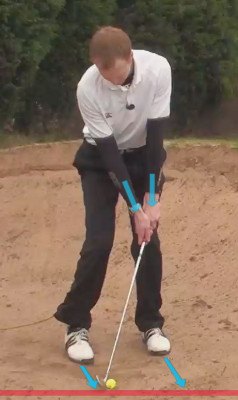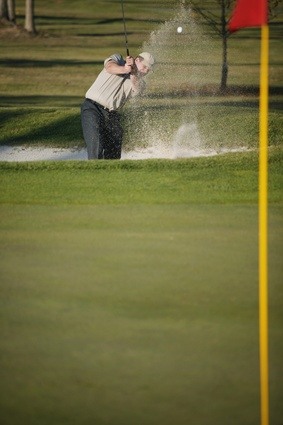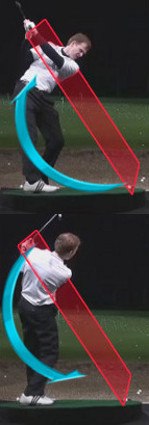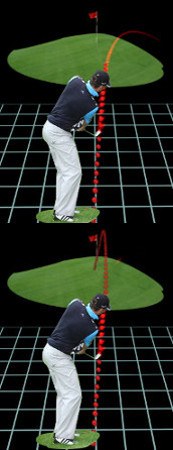
The conventional play from a greenside bunker is a blast or explosion shot, where the golfer hits the sand before the ball. While this is usually the best (or only) option, there are times when the ball can be chipped out instead.
Two conditions must be met in order to chip. First, the ball must sit cleanly atop the sand (the firmer, the better). Second, the bunker's lip must be low enough that a very low shot will clear it.
If the circumstances are right, here's how to chip from a bunker.
• Use a club with less loft and bounce than a sand wedge. For example, a 7- or 8-iron. For a medium to long shot, hybrid clubs are a great choice.
• Play the ball in the middle of your stance or just behind, and make sure your hands are ahead of the club at address.
• Keep your wrists firm and hit the ball with a slightly descending blow. If you contact the sand at all, it should be after the ball.
• Since a well-struck chip from sand will spin more than a shot from grass, expect the ball to roll less than usual once it lands.

When and How to Chip from a Bunker
The explosion shot is the play that is most often used from a greenside bunker. If you have any experience at all on the golf course, you are certainly familiar with this shot. The club is placed into the sand a couple of inches behind the ball using an aggressive swing, and the sand is blasted up out of the bunker toward the target. The club doesn't even actually hit the ball – it simply propels the sand, which in turn carries the ball out of the bunker and onto the green. When executed correctly in the right circumstance, the explosion shot is a great way to get your ball out of trouble and set up a short putt.
Unfortunately, not every situation that you encounter in a bunker is going to be a good fit for an explosion shot. To hit a good blast out of the bunker, you need to have plenty of room to make the swing, you need to have plenty of sand under the ball, and you need to have somewhere to stand comfortably while hitting the shot. If any of those elements are missing, you may have difficulty executing a good explosion shot. So, what do you do when the explosion shot is out of the question from a greenside bunker? You may have to resort to simply chipping the ball out of the sand and onto the green.
Chipping from a bunker isn't always going to be a good option – in fact, most of the time it will be the wrong choice. However, if you can employ this strategy at just the right time, you will be able to get yourself out of a tough spot, and maybe even save your par. Since you should already know how to make a chipping swing with your wedges, you don't really need to learn any new technique to hit this shot – you just need to know how to modify your current chipping technique in order to make it work from the bunker.
Shot selection is one of the main keys to playing good golf, and that certainly holds true in this case. Picking the right shot for the situation that you are facing in a greenside bunker will go a long way toward determining your success or failure. Most golfers focus only on the physical execution of their shots, and that is a mistake. While you obviously need to execute your technique properly in order to get good results, you also have to have a smart game plan in the first place. Even the best technique in the world won't lead you to a good shot if you have a bad plan, so pay attention to your shot selection if you would like to become a better player.
All of the instruction below is based on a right handed golfer. If you happen to play left handed, please take a moment to reverse the directions as necessary.

The Right Conditions
The biggest considerations when thinking about chipping from a bunker are the condition of the bunker, the lie of the ball, and the topography of the course in front of you. This shouldn't be a decision that you make simply because you want to chip the ball out of the sand – it should be a choice you make because the course is calling for a chip shot rather than an explosion.
If you walk into the bunker and see all of the three conditions listed below are being met, you may want to strongly consider opting for the chipping method to get out of the sand.
- Firm sand. This is the most important point of all to watch out for in the bunker. If your ball is sitting on top of some firm sand, you may be in a position from which to chip. It will be nearly impossible to chip the ball successfully if the sand is soft and fluffy, so feel the condition of the bunker with your feet as you walk up to your ball. Are your feet digging into the sand, or is it more like walking on a wet beach? If the sand is firm and your ball is sitting right on top with no sand behind the ball, you may have the green light to chip (provided the following two qualifications are also met). Remember, you can't touch the sand with your club prior to hitting the shot, so you will have to do your evaluation with your eyes and feet only.
- Low bunker edge. Often, when playing a greenside bunker shot, you will face a steep lip in front of you that must be cleared if you are going to get the ball on the green and near the hole. If you are facing a steep edge between you and the hole for the bunker shot in question, chipping is probably going to be a no-go. Playing a chip shot from a bunker is going to result in a relatively low trajectory, meaning you may not be able to get the ball up high enough to clear the edge and reach the green. An explosion shot will generally travel much higher than a chip shot, so that should be your first choice if at all possible. The last thing you want to do is leave the ball in the bunker and have to play the same shot again, so pick the option that gives you the easiest path back onto the grass.
- Plenty of room between you and the hole. If you are short sided, meaning the hole is close to your location in the bunker, you will usually be better off hitting an explosion shot. The blast from the sand comes out soft, and the ball usually has a decent amount of backspin to allow it to stop quickly. This is not the case with a chip from the sand. While you might get some spin, the ball is going to come out low and quick, making it difficult to stop the shot only a few feet out of the bunker. You want to be able to make an aggressive move through the ball when trying to hit a bunker chip, and you can't do that when the hole is just a few steps onto the green. Save the bunker chip for longer shots, and stick with the explosion as much as possible if you need a short shot up onto the green.
So, the three main criteria for deciding to hit a chip shot from the bunker are having plenty of green to work with, a low lip in front of you, and firm sand conditions under the ball. Lacking any one of these three points will make it extremely difficult to hit a good chip, so make sure to carefully evaluate the situation before proceeding with your shot of choice.

The Right Technique
Now that you know when you should opt for the chip shot from a bunker, you need to know exactly how to execute this tricky shot. Chipping out of a bunker isn't the most difficult thing you will try on the golf course, but it isn't the easiest, either. You have to make clean contact with the ball to avoid hitting the shot fat, as the sand below your ball will grab the leading edge of the club quickly if you give it a chance. Master your technique to clip the ball cleanly and you can hit solid chips time after time.
To start with, you should understand that you want to keep your chipping technique basically the same from when you chip off of the grass. There isn't much that needs to be changed, so you can start with that base and then make a few tweaks as necessary. The following three adjustments are everything you should need to know in order to translate your grass chipping technique into the bunker.
- Open farther to the left. You should already be chipping from a stance that is open out to the left of the target. However, when chipping from a bunker, you want to exaggerate this part of your stance so that your feet are pointed significantly to the left of the target. Why? Opening your stance will cause you to swing the club on an outside-in path, meaning the club will be taking a steeper approach into the ball. You want to swing down steeply in the bunker so that you can avoid hitting the shot fat, as a shallow chipping motion is likely to cause the club to catch some sand before the ball. Experiment with different stances during practice until you find a position that makes it easy for you to achieve clean contact.
- Longer backswing. Normally, when hitting a short chip shot, you don't need much of a backswing to pop the ball up onto the green. Unless you are chipping from deep rough, you can just move the club gently back and through and the ball will roll up nicely toward the hole. The story is a little different when chipping from the bunker. You want to make a longer backswing in order to give your downswing plenty of room to build momentum. If you make a short backswing, you might find that you need to force the forward swing to accelerate quickly – and you could hit the ball fat or thin as a result. Use a longer backswing and keep the club moving at a consistent pace through impact to achieve solid contact.
- Perfect head position through impact. It is always important in golf to keep your eyes on the ball – but perhaps nowhere around the course is it as important as when you are chipping from the bunker. Quality contact is paramount, and that starts with keeping your head and eyes perfectly still until impact has been reached. Throughout your swing, keep your eyes trained on the top of the ball and don't allow them to move in any direction. You will be tempted to look up quickly to see if the ball has gotten out of the bunker, but resist this urge and keep your eyes down. With enough discipline, you should be able to keep your head in place and strike the ball right on the center of the face.
While none of these three adjustment are particularly significant, they are all important. Take time to practice chipping from a bunker in order to work on these points and learn how the ball will come out off of all your different wedges. Knowing what to expect in terms of trajectory is a big part of the puzzle, and you are only going to gain that information by practicing this specific shot. Take just a few minutes out of your practice routine on a regular basis to chip some bunker shots and you will successfully add this shot to your repertoire.

What to Expect on the Green
For a bunker shot to be successful, you need to know what to expect when the ball lands on the green. Is it going to take a big bounce and roll out, or is it going to skip once and stop cold? Knowing what to expect will mean the difference between hitting a great shot and leaving a long putt for your par. As you might suspect, the reaction of the ball on a bunker chip shot is going to be significantly different from the reaction you will get after an explosion shot.
First, you should expect a big first bounce when playing a chip shot out of the sand. Since the ball is going to come out lower and quicker than an explosion shot, the first bounce will likely be long and flat. Even when the greens aren't particularly firm, you will still likely get a big hop up toward the hole. If playing uphill, this hop may be shortened by the slope, so the ball will stop quicker. Of course, if chipping downhill, the bounce will be even longer, and it could take quite some time for the ball to come to a rest.
The big question for every greenside bunker chip shot is what is going to happen to the ball after that first hop. With the first bounce out of the way, the spin on the ball will now have a chance to play a role – is there enough spin to stop the ball cold, or does it keep bouncing and rolling for several more yards? The answer to this question is going to depend on a number of factors. Review the following list to give yourself a good chance to guess accurately at the behavior of the ball after the first bounce.
- No spin when wet. If you are playing on a wet day (as will often be the case when you find firm bunkers that require chipping), you shouldn't expect the ball to stop quickly due to spin. The wet surface of the green will likely cause the shot to skid, and the spin won't have much of a chance to take hold. Friction is reduced on a wet surface, and spin needs friction in order to bring your ball to a stop.
- Club loft matters. When you play the bunker chip with a highly lofted club like a lob wedge, you will have a good chance to create quite a bit of spin. On the other hand, playing this shot with a nine iron or pitching wedge will virtually guarantee that you don't put much spin on the ball. So, when making your club selection for the chip, think about the path you want to take to the hole and decide if more or less spin is going to give you an advantage. Also, you will need to take into account the ground between your ball and the hole when determining club selection. A shot that requires more carry will demand that you use more loft than a shot which only needs to carry a short distance before reaching the putting surface.
- Golf ball matters. One of the often-overlooked elements of spin in general is the golf ball that you choose to play. Using a soft ball capable of plenty of spin will make it far more likely that your shots will stop quickly on the green. Using a cheap, hard golf ball will make it nearly impossible to achieve any kind of backspin from the bunker. You don't need to pick out a golf ball model specifically with bunker chip shots in mind, but remember what ball you are playing as you plan your shot. If you think spin is likely, aim for a spot closer to the hole – if you doubt any backspin will take hold, allow yourself more space to roll the ball up to the target.
One of the biggest differences between professional golfers and their amateur counterparts is the pro's ability to predict how the ball will react on the ground. It is one thing to hit your target in the air – it is another thing to properly guess what the ball is going to do once back down on the grass. Only when you master this skill can you actually put the ball near the target over and over again.

Common Mistakes
By far, the most common problem that will be experienced by the average golfer when trying to chip from the bunker is hitting the shot fat. It is only natural to feel like you need to 'help' the ball into the air when hitting this shot, so you may bottom out the swing just prior to reaching the ball in an effort to lift it out of the sand. Obviously, this is a mistake, but it is a tough mistake to prevent at first. The only way to get over this problem is to spend plenty of time practicing this shot. If you can work on hitting chip shots from firm sand, you will soon learn that you can hit down on the ball and have it come up into the air nicely. Hopefully, after some work in the practice area, you will get to the point where you can trust this kind of shot on the course.
Another mistake that is frequently seen on these shots is a lack of commitment through the hitting area. If you get nervous right before making contact with the ball, you may lose speed and wind up leaving the ball right in front of you in the bunker. It is important that you are fully committed to this type of shot before you ever put the club in motion. If you aren't sure that chipping from the bunker is the right play, take a step back and reevaluate the situation. Golf is a game that is all about confidence, and there really is no room for doubt in your mind if you are going to succeed. Create a clear picture of the shot you are trying to hit, and then execute that shot to the best of your ability.
One final mistake that you need to watch for is simply not using enough loft. It is a bad feeling to catch the ball perfectly at impact only to see it hit right into the bank of the bunker in front of you, so always error on the side of too much loft as opposed to too little. It is okay to clear the lip of the bunker by a couple of feet, but it will be a painful mistake to miss clearing that same lip by even one inch.
Realistically, you probably won't find the need to chip from a bunker more than once every few rounds. However, if you are comfortable with this shot and you have it in your arsenal just in case, it can save you a stroke (or more) when the circumstance does arise. Take a little bit of time now to learn how to chip from bunkers and you will be prepared if the opportunity comes up during a future round.






